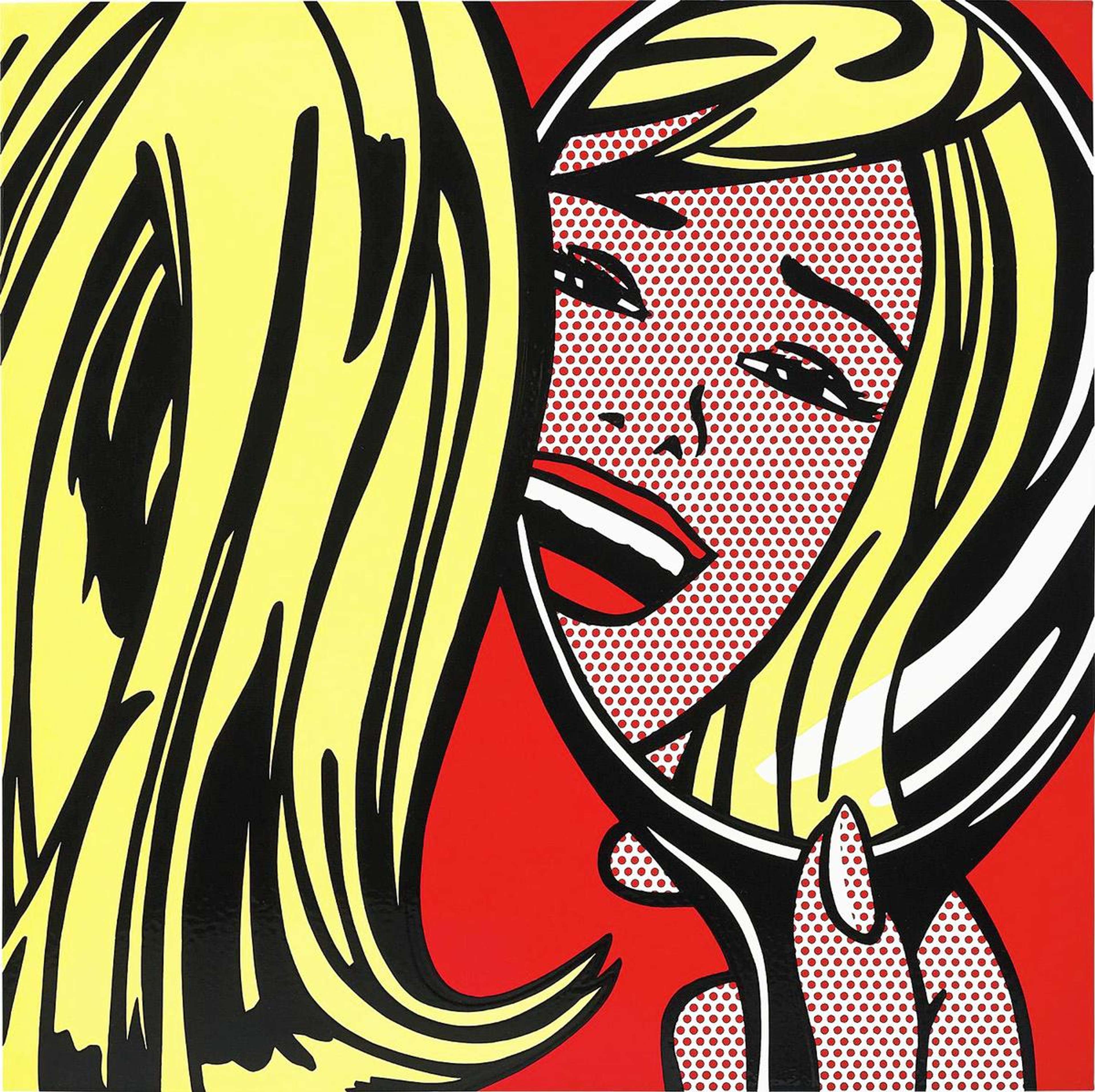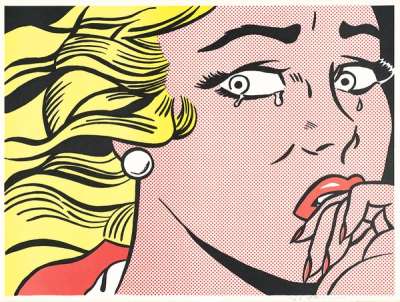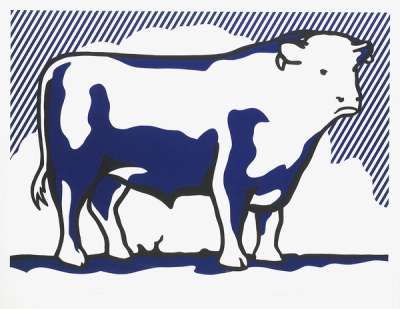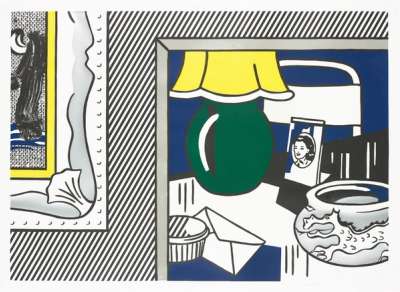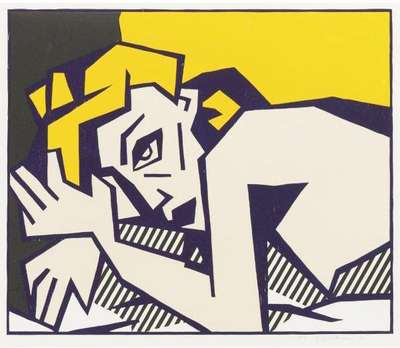Roy Lichtenstein vs Art History

 Image © Creative Commons via Wikimedia / Roy Lichtenstein 1967
Image © Creative Commons via Wikimedia / Roy Lichtenstein 1967
Roy Lichtenstein
286 works
Roy Lichtenstein (1923-1997) was a prominent figure of the American Pop Art movement. Acclaimed for his bold graphic style that borrowed heavily from the aesthetics of commercial print media, his works have sparked debates and controversies regarding the originality and authenticity of his art.
The major criticism of Lichtenstein's work is that he directly appropriated the work of comic book illustrators without adequately acknowledging their creative input. Some believe that his work merely repackaged the efforts of original illustrators for the high art market, thus exploiting their unrecognised artistic labour. Where will Lichtenstein sit on the annals of art history?
 Image © Tate / Whaam! © Roy Lichtenstein 1963
Image © Tate / Whaam! © Roy Lichtenstein 1963Roy Lichtenstein's Artistic Style and Techniques
Lichtenstein's style is characterised by its comic book-like aesthetic and his use of Ben Day dots, which he hand-painted or used stencils to create. This technique was commonly used in newspapers and comic books to create shading and secondary colours. In his paintings, Lichtenstein used this method to replicate the mechanical, impersonal quality of commercial printing. His style is notable for its simplification and stylisation, as he often removed elements from their original context and distilled them, focusing on their most basic components. His art might seem straightforward, but often involves a sophisticated interplay of shapes, colours and lines.
His choice of subject matter often leaned toward the mundane or kitschy, including romance and war scenes straight from pulp comics or objects of everyday life. Lichtenstein would typically borrow images, enlarge them and alter them slightly, although they would remain unmistakably close to their sources. His innovative techniques and styles challenged traditional boundaries between 'high' and 'low' art.
Some of his most famous works, such as Whaam!, exemplify this. Created in 1963, during the height of the Pop Art movement, this large diptych depicts an intense scene of aerial combat, with one fighter jet firing a rocket at another, which explodes in a vibrant display of red and yellow, with the word "WHAAM!" written in large letters, emulating the onomatopoeic text often found in comics. The scene is directly appropriated from a 1962 issue of DC Comics' All-American Men of War, with stylistic modifications. Whaam! is often seen as a commentary on the growing influence of mass media and the role that plays in the normalisation of violence. As a seminal artwork from the Pop Art movement, the painting now hangs at the Tate Modern in London.
Another iconic work is Drowning Girl, which depicts a woman submerged in water up to her chin, with a speech bubble saying "I Don't Care! I'd Rather Sink — Than Call Brad for Help!" The image is dramatic yet humorous, capturing a moment of emotional crisis in a single frame. Lichtenstein uses his characteristic thick lines, bold colours, and Ben-Day dots to give the image a polished, mass-produced feel. The scene is derived from a 1962 DC Comics book called Secret Hearts. Lichtenstein cropped the original comic book frame, removing secondary elements to focus on the crying woman, heightening the emotional intensity and isolating the melodrama typical of the romance comics of the period. Today, Drowning Girl remains a significant work in the pop art movement and is on show at the Museum of Modern Art in New York.
Lichtenstein's Influences and Sources of Inspiration
Lichtenstein's use of comic book imagery was a defining feature of his style. As we have seen, he often selected individual panels from romance and war comics, cropping them and altering them slightly before transferring them onto his canvases. Lichtenstein would reproduce the exact lines of the comic book illustrators, blown up and carefully composed, often with a heavy use of primary colours. Lichtenstein's transformation of pop culture sources into fine art was a hallmark of his career and a central tenet of the Pop Art movement.
Beyond comics, Lichtenstein's art shows an appreciation for and appropriation of a broad range of art historical styles and movements. He created a series of paintings in the 1960s directly referencing masterpieces by artists such as Picasso, Cezanne and Mondrian. However, he didn't merely replicate these works, he 'Lichtenstein-ified' them, subjecting these pieces to his distinctive style and creating a clever dialogue with the tradition of Western art. This playful remix of classic artworks can be seen as a challenge to the art establishment and its sanctification of certain works. Lichtenstein was perhaps suggesting that all art is, in a sense, derivative, and that 'high art' and 'low art' might not be as far apart as traditionally believed.
Moreover, by replicating the visual style of commercial printing, Lichtenstein blurred the line between mass-produced and unique art objects. Like Andy Warhol, he challenged the idea that a unique, handcrafted object was inherently more valuable than a mass-produced one. Through these strategies, Lichtenstein not only transformed pop culture sources into fine art, but also prompted a reevaluation of what constitutes art itself. He invited viewers to see the artistic value in everyday objects and media, and to question the established hierarchies of taste and value in the art world.
Lichtenstein and Appropriation: Genius or Plagiarist?
Lichtenstein's appropriation has sparked debates, especially for exploiting the original comic book artists by using their work without credit or compensation. Lichtenstein's intention was not to copy comic strips, but to transform them. He aimed to elevate the comic, a form associated with low art, by adopting its visual language and presenting it within the high art context of a gallery or museum. This also reflected broader cultural trends of his time. During the 1960s, mass-produced images and goods were becoming a central part of everyday life. By drawing on this ubiquitous imagery, Lichtenstein and his fellow Pop Artists challenged the elitism of the art world and encouraged viewers to see artistic value in the everyday.
The ethical implications of Lichtenstein's work are complex. His lack of credit to the original comic artists is often seen as problematic, but his comic paintings were less about individual comics and their creators and more about the comic strip as a cultural phenomenon – the stereotypes, narratives and aesthetics it propagated.
Whether one views Lichtenstein as a genius or a plagiarist largely depends on one's perspective on appropriation in art. His work undoubtedly treads a fine line between inspiration and copying, raising uncomfortable questions about the nature of creativity and the sanctity of original works. Nevertheless, it's hard to deny the impact Lichtenstein had on the art world, broadening the definition of what could be considered art and encouraging a more inclusive and democratic view of cultural production.
Appropriation in Art: History and Controversies
There is a long history of appropriation in art, which has taken various forms throughout different artistic movements. One of the most notable examples is Marcel Duchamp's Fountain, an ordinary urinal turned into an artwork by the mere act of the artist signing it and placing it in a gallery context. The 1950s and 1960s saw the rise of Pop Art, which heavily used appropriation. Artists such as Warhol took images and objects from popular culture and transformed them into fine art, challenging the distinction between high and low culture. Similarly, the Pictures Generation artists in the 1970s and 1980s, including Sherrie Levine and Richard Prince, directly rephotographed existing photographs, highlighting the proliferation and manipulation of images in a media-saturated society. In the 21st century, digital technologies have further complicated the issues around appropriation, making it easier than ever to copy, alter and distribute images.
Appropriation raises complex ethical and artistic questions. On one hand, it challenges traditional notions of originality and authorship. If art is about unique self-expression, what does it mean when an artwork includes borrowed or stolen elements? Yet some argue that all art is derivative to some extent, and that appropriation can be a valid and even innovative artistic strategy. Appropriation has always been a controversial practice, with artists who indulge in it often facing accusations of plagiarism and copyright infringement. Prince, for instance, has been sued multiple times for his use of appropriated photographs. Similarly, Shepard Fairey faced legal action for his use of a photograph of Barack Obama in his famous HOPE poster.
From an ethical standpoint, the key issues often revolve around consent, credit and context. Is it right to use someone else's work without their permission? Is it important to credit the original source? And does the context in which an image is used change its meaning? Moreover, appropriation can become a matter of cultural sensitivity, especially when artists take images or symbols from cultures other than their own. This can be seen as cultural appropriation, a form of theft that perpetuates power imbalances and disrespects the original context and meaning of these cultural elements.
While appropriation in art can lead to innovative and challenging artworks, it also poses significant ethical and legal dilemmas. The controversies it sparks highlight the complex interplay between creativity, originality and ownership in the art world, and these debates continue to evolve in response to changing cultural and technological landscapes.
Lichtenstein's Legacy and Influence
Despite any questions raised on authenticity, Lichtenstein's work has had a profound impact on contemporary art. As a leading figure in the Pop Art movement, he helped legitimise the use of mass culture as a worthy subject. Lichtenstein's work also anticipated several key themes of postmodernism, and his appropriation of existing images questioned the notion of originality and authenticity. His blending of ‘high' and 'low' culture also reflects contemporary resistance to hierarchical distinctions between different forms of art and culture.
Today, Lichtenstein's legacy remains strong. His graphic style is often referenced, and his exploration of everyday imagery and commercial aesthetics continues to resonate in our media-saturated society. Moreover, Lichtenstein's use of appropriation has become increasingly relevant in the digital age, where images can be easily copied, manipulated and shared.
His work continues to inspire artists, particularly those interested in the interplay between pop culture and fine art. His approach to art-making — treating all of culture as a valid source of inspiration, questioning traditional hierarchies of taste and exploring the tension between originality and replication — represents a radical shift in the way we think about art.
A Fresh Perspective on Lichtenstein and Art History
Lichtenstein's relationship with art history is thus complex and multifaceted. On one hand, his work is known for citing the popular visual culture of his time. On the other, it consciously engages with the history of art, invoking, referencing and reworking its established icons and styles. His appropriation of comic book illustrations might be viewed in a different light when seen in the context of his wider engagement with art history, and his borrowing might be seen as a valid form of homage, underlining the artistic quality of these illustrations.






